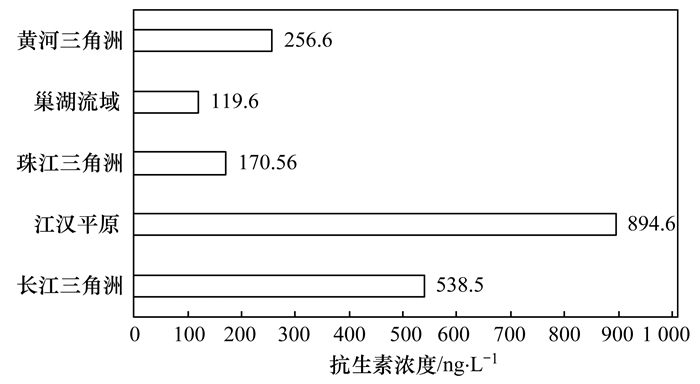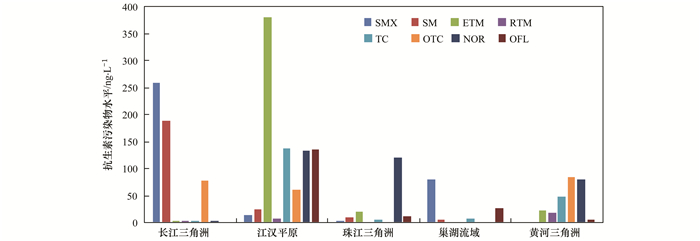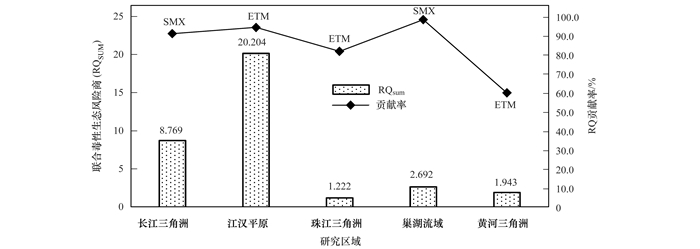2. 中国科学院大学, 北京 100049;
3. 中国科学院武汉植物园水生植物与流域生态重点实验室, 武汉 430061
2. University of Chinese Academy of Sciences, Beijing 100049, China;
3. Key Laboratory of Aquatic Botany and Watershed Ecology, Wuhan Botanical Garden, Chinese Academy of Sciences, Wuhan 430061, China
抗生素是一类具有抵抗微生物活性的天然、半合成或人工合成的化合物, 大量应用于人和动物的感染性疾病的预防与治疗中[1, 2].与对其他环境污染物, 如重金属、化学肥料、农药、多环芳烃等的高认知程度不同, 抗生素污染作为一类新型污染物在近年来才受到国内外学者的重视[3].有研究表明[4~6], 随着抗生素的大量生产与广泛使用, 其环境污染与生态毒理效应已不容忽视, 成为全球面临的重大环境问题之一.
我国是抗生素的生产和使用大国, 医用和畜牧业抗生素滥用情况严重[7], 年均使用量约2.5万t, 占到全球总使用量的20%左右[8, 9].在我国, 抗生素大量进入环境中形成“假持久性”现象[10, 11], 诱导环境中耐药性致病菌的出现, 对人体健康和生态环境产生威胁[12].目前国内外对于含抗生素废水的治理技术不多且不成熟, 污水处理厂常用的活性污泥法或生物滤池法对于废水中抗生素的处理效果不明显[13], 葛峰等[14]对南京市4个污水处理厂活性污泥中细菌的抗生素耐药性进行分析, 结果表明活性污泥中细菌耐药性严重, 危害水产养殖业的多种细菌具有严重的多重耐药性, 对人体健康和生态系统稳定性构成潜在威胁.
我国的抗生素污染问题在近年来才逐步受到学者们的重视并对其进行了报道.章强等[15]的研究表明, 目前已经在我国地表水(河流、湖泊)、地下水及水体沉积物中检测出抗生素残留, 养殖业废水和城市污水是抗生素的主要污染来源; Zhang等[16]于2015年发布我国首份抗生素污染排放地图, 揭示了我国抗生素污染的空间分布格局, 我国京津地区及东部沿海地区受抗生素污染最为严重; 王敏等[17]对5种典型滨海养殖水体(鱼塘、螃蟹池、蛏池、虾池、鸭池)中抗生素的残留类型和浓度进行了研究, 结果表明螃蟹养殖中抗生素残留最少, 虾养殖水体中最多; 有学者也对我国地表水及沉积物中的抗生素污染进行了生态风险评价, 如北京清河[18]、大辽河[19]、深圳铁岗水库[20]、洪湖[21]和辽河[22]等, 这些研究结果表明其环境风险与生态毒理效应不容忽视.
目前, 水体污染物生态风险评价主要有3种方法:风险商值法(risk quotient, RQ)、概率生态风险法(probabilistic ecological risk assessment, PERA)和物种敏感性分布法(species sensitivity distribution, SSD)[23].本研究中采用的风险商值法(RQ)是一种常用方法, 其对毒理数据的要求较少.本文在已有研究基础上综述了我国5个典型地表水环境中抗生素的污染现状, 采用风险商值法评估其潜在的生态环境风险, 通过全面了解中国水体抗生素污染现状及其生态风险, 以期为抗生素污染防治提供参考资料.
1 材料与方法 1.1 研究区域与数据来源本文选取长江三角洲、珠江三角洲、黄河三角洲及江汉平原、巢湖流域等地区为研究区域, 综述国内外文献, 分析我国水环境中的抗生素污染现状.研究区域选取的依据是:长江三角洲和珠江三角洲是我国经济发展最快的地区之一; 江汉平原位于素有“千湖之省”美称的湖北省, 是我国水资源和水产资源最为丰富地区之一; 黄河三角洲位于黄河入海口, 是我国最大的三角洲, 自然资源丰富; 巢湖位于安徽合肥, 连淮通江, 是我国第五大淡水湖泊.
针对中国典型地表水环境, 本文收集并整理了近5年以来国内外公开发表的相关资料, 包括5个区域内5大类17小类抗生素含量的数据.数据的筛选遵循以下原则:资料中抗生素的测定方法为美国EPA推荐的标准方法或根据标准方法修订的方法; 分析方法遵循质量保证和控制程序, 使用空白、重复和标准物质对测量的精度进行控制.不同种类抗生素的毒理数据参考美国环保署EPA ECTOX数据库(http://www.epa.gov/ecotox/).
我国水环境中存在的抗生素主要包括5大类20种, 分别为四环素类(TCs)、氯霉素类(CPs)、磺胺类(SAs)、氟喹诺酮类(FQs)和大环内酯类(MLs).其中, 磺胺类(SAs)药物广泛应用于畜牧生产中, 能有效防治动物疾病[24].抗生素具体种类见表 1.
|
|
表 1 我国水环境中主要存在的抗生素种类 Table 1 Main types of antibiotics in China's water environment |
1.2 评价模型与方法
水环境中残留抗生素的生态风险可以用风险商值(RQ)来进行评价, 根据RQ值可评价其在水环境中的生态风险大小[25].有研究结果表明[26], 当0.01 < RQ < 0.1时, 为低风险; 当0.1 < RQ < 1时, 为中风险; 当RQ>1时, 为高风险. RQ计算公式如下:

|
(1) |
式中, MEC为实测浓度, ng·L-1; PNEC为预测无效应浓度, 即在目前的研究中尚未发现其对生态系统产生不利影响的最大浓度, ng·L-1.

|
(2) |
式中, LC50为半致死浓度, EC50为最大半效应浓度, 两者单位均为ng·L-1; LC50和EC50的值从美国环保署的EPA ECTOX数据库中获得, 当存在多个值时, 取最小值[20]; AF为评价因子, 取欧盟水框架指令的推荐值(1000).

|
(3) |
式中, RQSUM为联合毒性风险商, RQi为某种抗生素i的RQ值.
有研究表明[27, 28], 当多种抗生素共同存在于水环境中时, 其生态毒理效应和环境危害程度会加强.然而, 目前关于抗生素环境风险的研究多集中于单一药品, 缺乏对其联合生态效应的考察.因此, 本文采用简单叠加模型计算抗生素的联合毒性风险商[29].
2 结果与讨论 2.1 污染现状在未受人类活动影响的自然环境介质中, 微生物是抗生素的生产者, 但微生物产生的抗生素含量极低, 属于微生物自然防御机制[30], 因此, 人为活动影响是我国水环境抗生素的主要来源.目前, 医用抗生素和兽用抗生素在我国使用频繁, 而传统的污水处理厂工艺不能有效去除微量污染物, 含有抗生素废水经城市集污系统进入污水处理厂而进入水环境[31].
5个不同地区地表水中抗生素的污染类型与污染水平如表 2.不同地区所表现出的主要抗生素污染种类有差异, 相同地区不同月份间的抗生素污染水平也呈现差异化.
|
|
表 2 地表水中主要抗生素的污染水平1)/ng·L-1 Table 2 Pollution levels of major antibiotics in surface water/ng·L-1 |
比较相同地区丰水期与枯水期水体中的抗生素污染水平.在江汉平原地区, 丰水期(5月)大部分抗生素的浓度较枯水期(10月)有明显升高, 磺胺类抗生素含量在两个时期差别不明显, 但大环内酯类ETM丰水期浓度为381.5 ng·L-1, 枯水期为4.0 ng·L-1, 四环素类TC丰水期和枯水期浓度分别为137.4 ng·L-1和15.8 ng·L-1, 其他各类抗生素浓度在两季中也呈现差异, 最大差值达到近百倍, 总体上来看丰水期高于枯水期; 在珠江三角洲和巢湖流域地区, 丰水期(9月)各类抗生素含量均低于枯水期(1月或2月), 磺胺类抗生素含量差别尤为明显, 在江汉平原SMX枯水期为218 ng·L-1, 丰水期仅为3.6 ng·L-1, 在巢湖流域SMX枯水期为171.6 ng·L-1, 丰水期为79.6 ng·L-1, 其他各类抗生素含量枯水期略高于丰水期, 相差约1.5~8.0倍; 在黄河三角洲, 除TC、ENR和OFL等3种抗生素外, 丰水期(9月)抗生素含量高于枯水期(4月), 但两个时期抗生素含量差别不明显, 在1.3~30.9 ng·L-1.丰水期与枯水期抗生素污染水平的差异, 可能与农田播种、水产养殖投苗, 病虫害防治时抗生素药物的使用方式与时期密切相关.
比较5个地区丰水期水体中的抗生素污染水平.如图 1所示, 黄河三角洲、巢湖流域、珠江三角洲、江汉平原和长江三角洲这5个地区的抗生素总含量分别为256.6、119.6、170.56、894.6和538.5 ng·L-1, 其中江汉平原作为密集农业区污染水平最高, 巢湖流域污染水平最低, 这可能与不同地区抗生素的使用种类与用量、水产养殖施用量、环境条件差异有关[37].按照抗生素污染水平由高到低排序为:江汉平原>长江三角洲>黄河三角洲>珠江三角洲>巢湖流域, 抗生素总含量在119.6~894.6 ng·L-1.

|
图 1 5个地区丰水期水环境中抗生素污染水平 Fig. 1 Antibiotic concentration in different surface-water environments during the wet season |
目前, 有大量研究结果表明, 抗生素对水生生物、土壤生物和植物造成不利影响, 具有毒性效应[12].抗生素对水生生物产生直接影响, Wollenberger等[38]测试了9种兽用抗生素对淡水水蚤的急性毒理效应, 结果表明, 最大半效应浓度最低仅为4.6 mg·L-1; 抗生素对土壤生物和植物的影响可能是间接的, 因为实际中土壤环境较为复杂, 土壤生物和植物还有可能受到重金属污染等其他方面的影响, 有待进一步研究[12].
通过表 3可以看出, 在本文5个研究区域内检测出的17种目标抗生素中, 主要受到其中8种抗生素污染的生态风险, 分别是磺胺甲基异噁唑(SMX)、磺胺甲基嘧啶(SM)、红霉素(ETM)、罗红霉素(RTM)、四环素(TC)、氧土霉素(OTC)、诺氟沙星(NOR)和氧氟沙星(OFL), 其无效应浓度PNEC值分别为30、1 740、20、150、415、170、1 600和1 440 ng·L-1, 一般来说, 在相同暴露浓度下, 无效应浓度PNEC值越大其潜在生态风险越小, 故本文将重点讨论这8种抗生素在5个研究区域内的生态风险, 其在丰水期的浓度与组成如图 2.
|
|
表 3 目标抗生素的PNEC值1)/ng·L-1 Table 3 PNEC values of target antibiotics/ng·L-1 |

|
图 2 主要目标抗生素丰水期浓度与组成 Fig. 2 Concentration and composition of target antibiotics during the wet season |
本文基于前人研究成果和国内外研究报道, 对选取5个区域的丰水期(4~10月)抗生素污染进行风险评价, 污染现状见表 2.长江三角洲选取2012年7月数据, 江汉平原选取2014年5月数据, 珠江三角洲选取2011年9月数据, 巢湖流域选取2012年9月数据, 黄河三角洲选取2014年9月数据, 具体的生态风险商RQ计算结果见表 4.
|
|
表 4 丰水期不同地表水体中抗生素生态风险商 Table 4 Risk quotients in different surface-water environments during the wet season |
长江三角洲水体中RTM、TC和NOR的RQ低于0.01, 无明显生态风险; SM、ETM和OTC的RQ高于0.1但低于1, 处于中风险; 而SMX的RQ高达7.987, 远高于1, 对RQSUM的贡献率为91.1%, 说明该类抗生素为该地区的主要污染物, 处于高风险, 其对生态环境的危害作用较大.
江汉平原地区水体中SM、RTM、NOR和OFL的RQ高于0.01但低于0.1, 该地区受到这4类抗生素的威胁很小, 处于低风险; SMX、TC和OTC的RQ高于0.1但低于1, 其污染水平属于中风险; ETM的RQ值高达19.075, 对RQSUM的贡献率为94.4%, 为该地区的主要抗生素污染物类型, 处于高风险.
珠江三角洲体中SM和OFL的RQ低于0.01, 生态风险商结果显示无风险; TC和NOR的RQ高于0.01但低于0.1, 处于低风险; SMX的RQ高于0.1但低于1, 处于中风险; ETM的RQ为1, 对RQSUM的贡献率为81.8%, 是该地区的主要抗生素污染类型, 处于高风险临界值.
巢湖流域水体中SM的RQ低于0.01, 不受到该类抗生素的生态威胁; TC和OFL的RQ高于0.01低于0.1, 风险商结果表明该地区受到这两类抗生素的威胁较低, 处于低风险; SMX的RQ高于1, 对RQSUM的贡献率高达98.5%, 是该地区的首要抗生素污染类型, 处于高风险.
黄河三角洲水体中OFL的RQ低于0.01, 无明显生态风险; NOR的RQ高于0.01低于0.1, 处于低风险; RTM、TC和OTC的RQ高于0.1低于1, 这3类抗生素对该地区的生态风险程度为中; ETM的RQ高于1为1.165, 对RQSUM的贡献率为60.0%, 是主要抗生素污染类型且处于高风险.
由图 3可以看出, 长江三角洲和巢湖流域RQ贡献率最高的抗生素污染物类型为SMX, 贡献率分别为91.1%和98.5%;江汉平原、珠江三角洲和黄河三角洲RQ贡献率最高的抗生素污染物类型为ETM, 贡献率分别为94.4%、81.8%和60.0%;同时, 根据风险商计算结果, 5个研究区域均受到抗生素污染的高生态风险(RQSUM>1), 生态风险由大到小排序为:江汉平原(20.204)>长江三角洲(8.769)>巢湖流域(2.692)>黄河三角洲(1.943)>珠江三角洲(1.222), 首要抗生素污染物类型为SMX和ETM.

|
图 3 联合毒性生态风险商RQSUM及主要抗生素RQ贡献率 Fig. 3 Joint toxicity ecological risk quotient and contribution rates of selected antibiotics |
(1) 5个研究区域内地表水环境在丰水期(4~9月)主要受到8种抗生素污染的生态风险, 分别是磺胺甲基异噁唑(SMX)、磺胺甲基嘧啶(SM)、红霉素(ETM)、罗红霉素(RTM)、四环素(TC)、氧土霉素(OTC)、诺氟沙星(NOR)和氧氟沙星(OFL).
(2) 生态风险商评价结果表明, 5个研究区域内的首要抗生素污染类型为SMX和ETM, 其对RQSUM贡献率在60%以上.
(3) 对生态风险商应用简单叠加模型计算得到RQSUM, 由大到小排序为:江汉平原(20.204)>长江三角洲(8.769)>巢湖流域(2.692)>黄河三角洲(1.943)>珠江三角洲(1.222).
| [1] | Halling-Sørensen B, Nors Nielsen S, Lanzky P F, et al. Occurrence, fate and effects of pharmaceutical substances in the environment-A review[J]. Chemosphere, 1998, 36(2): 357-393. DOI:10.1016/S0045-6535(97)00354-8 |
| [2] | Martinez J L. Environmental pollution by antibiotics and by antibiotic resistance determinants[J]. Environmental Pollution, 2009, 157(11): 2893-2902. DOI:10.1016/j.envpol.2009.05.051 |
| [3] | Bound J P, Voulvoulis N. Predicted and measured concentrations for selected pharmaceuticals in UK rivers:implications for risk assessment[J]. Water Research, 2006, 40(15): 2885-2892. DOI:10.1016/j.watres.2006.05.036 |
| [4] | Schwaber M J, Cosgrove S E, Gold H S, et al. Fluoroquinolones protective against cephalosporin resistance in gram-negative nosocomial pathogens[J]. Emerging Infectious Diseases, 2004, 10(1): 94-99. DOI:10.3201/eid1001.020663 |
| [5] | Zanetti G, Bally F, Greub G, et al. Cefepime versus imipenem-cilastatin for treatment of nosocomial pneumonia in intensive care unit patients:a multicenter, evaluator-blind, prospective, randomized study[J]. Antimicrobial Agents and Chemotherapy, 2003, 47(11): 3442-3447. DOI:10.1128/AAC.47.11.3442-3447.2003 |
| [6] | Arias C A, Murray B E. Antibiotic-resistant bugs in the 21st century——a clinical super-challenge[J]. New England Journal of Medicine, 2009, 360(5): 439-443. DOI:10.1056/NEJMp0804651 |
| [7] |
俞慎, 王敏, 洪有为. 环境介质中的抗生素及其微生物生态效应[J]. 生态学报, 2011, 31(15): 4437-4446. Yu S, Wang M, Hong Y W. Antibiotics in environmental matrices and their effects on microbial Ecosystems[J]. Acta Ecologica Sinica, 2011, 31(15): 4437-4446. |
| [8] | Wise R. Antimicrobial resistance:priorities for action[J]. Journal of Antimicrobial Chemotherapy, 2002, 49(4): 585-586. DOI:10.1093/jac/49.4.585 |
| [9] | Xu W H, Zhang G, Zou S C, et al. Determination of selected antibiotics in the Victoria Harbour and the Pearl River, South China using high-performance liquid chromatography-electrospray ionization tandem mass spectrometry[J]. Environmental Pollution, 2007, 145(3): 672-679. DOI:10.1016/j.envpol.2006.05.038 |
| [10] |
徐维海, 张干, 邹世春, 等. 典型抗生素类药物在城市污水处理厂中的含量水平及其行为特征[J]. 环境科学, 2007, 28(8): 1779-1783. Xu W H, Zhang G, Zou S C, et al. Occurrence, distribution and fate of antibiotics in sewage treatment plants[J]. Environmental Science, 2007, 28(8): 1779-1783. DOI:10.3321/j.issn:0250-3301.2007.08.023 |
| [11] | Gulkowska A, Leung H W, So M K, et al. Removal of antibiotics from wastewater by sewage treatment facilities in Hong Kong and Shenzhen, China[J]. Water Research, 2008, 42(1-2): 395-403. DOI:10.1016/j.watres.2007.07.031 |
| [12] |
高立红, 史亚利, 厉文辉, 等. 抗生素环境行为及其环境效应研究进展[J]. 环境化学, 2013, 32(9): 1619-1633. Gao L H, Shi Y L, Li W H, et al. Environmental behavior and impacts of antibiotics[J]. Environmental Chemistry, 2013, 32(9): 1619-1633. |
| [13] |
张玮玮, 弓爱君, 邱丽娜, 等. 废水中抗生素降解和去除方法的研究进展[J]. 中国抗生素杂志, 2013, 38(6): 401-410. Zhang W W, Gong A J, Qiu L N, et al. Processes of degradation and removal methods of antibiotics from waste water[J]. Chinese Journal of Antibiotics, 2013, 38(6): 401-410. DOI:10.3969/j.issn.1001-8689.2013.06.001 |
| [14] |
葛峰, 郭坤, 周广灿, 等. 南京市4个污水处理厂的活性污泥中细菌的分离鉴定和抗生素耐药性分析[J]. 环境科学, 2012, 33(5): 1646-1651. Ge F, Guo K, Zhou G C, et al. Isolation and identification of bacteria in the activated sludge from four sewage treatment plants in Nanjing City and its antibiotic resistance analysis[J]. Environmental Science, 2012, 33(5): 1646-1651. |
| [15] |
章强, 辛琦, 朱静敏, 等. 中国主要水域抗生素污染现状及其生态环境效应研究进展[J]. 环境化学, 2014, 33(7): 1075-1083. Zhang Q, Xin Q, Zhu J M, et al. The antibiotic contaminations in the main water bodies in China and the associated environmental and human health impacts[J]. Environmental Chemistry, 2014, 33(7): 1075-1083. |
| [16] | Zhang Q Q, Ying G G, Pan C G, et al. Comprehensive evaluation of antibiotics emission and fate in the river basins of China:source analysis, multimedia modeling, and linkage to bacterial resistance[J]. Environmental Science & Technology, 2015, 49(11): 6772-6782. |
| [17] |
王敏, 俞慎, 洪有为, 等. 5种典型滨海养殖水体中多种类抗生素的残留特性[J]. 生态环境学报, 2011, 20(5): 934-939. Wang M, Yu S, Hong Y W, et al. Residual characterization of multi-categorized antibiotics in five typical aquaculture waters[J]. Ecology and Environmental Sciences, 2011, 20(5): 934-939. DOI:10.3969/j.issn.1674-5906.2011.05.026 |
| [18] |
朱琳, 张远, 渠晓东, 等. 北京清河水体及水生生物体内抗生素污染特征[J]. 环境科学研究, 2014, 27(2): 139-146. Zhu L, Zhang Y, Qu X D, et al. Occurrence of antibiotics in aquatic plants and organisms from Qing River, Beijing[J]. Research of Environmental Sciences, 2014, 27(2): 139-146. |
| [19] |
秦延文, 张雷, 时瑶, 等. 大辽河表层水体典型抗生素污染特征与生态风险评价[J]. 环境科学研究, 2015, 28(3): 361-368. Qin Y W, Zhang L, Shi Y, et al. Contamination characteristics and ecological risk assessment of typical antibiotics in surface water of the Daliao River, China[J]. Research of Environmental Sciences, 2015, 28(3): 361-368. |
| [20] |
朱婷婷, 段标标, 宋战锋, 等. 深圳铁岗水库水体中抗生素污染特征分析及生态风险评价[J]. 生态环境学报, 2014, 23(7): 1175-1180. Zhu T T, Duan B B, Song Z F, et al. Pollution characteristics and ecological risk assessment of antibiotics in Tiegang Reservoir in Shenzhen[J]. Ecology and Environmental Sciences, 2014, 23(7): 1175-1180. DOI:10.3969/j.issn.1674-5906.2014.07.013 |
| [21] | Wang Z, Du Y, Yang C, et al. Occurrence and ecological hazard assessment of selected antibiotics in the surface waters in and around Lake Honghu, China[J]. Science of the Total Environment, 2017, 609: 1423-1432. DOI:10.1016/j.scitotenv.2017.08.009 |
| [22] |
张晓娇, 柏杨巍, 张远, 等. 辽河流域地表水中典型抗生素污染特征及生态风险评估[J]. 环境科学, 2017, 38(11): 4553-4561. Zhang X J, Bai Y W, Zhang Y, et al. Occurrence, distribution, and ecological risk of antibiotics in surface water in the Liaohe River Basin, China[J]. Environmental Science, 2017, 38(11): 4553-4561. |
| [23] |
刘昔, 王智, 王学雷, 等. 应用物种敏感性分布评价中国湖泊水体中重金属污染的生态风险[J]. 湖泊科学, 2018, 30(5): 1206-1217. Liu X, Wang Z, Wang X L, et al. Ecological risks assessment of selected heavy metals in the waters of Chinese lakes based on species sensitivity distributions[J]. Journal of Lake Sciences, 2018, 30(5): 1206-1217. |
| [24] | Zhao J L, Liu Y S, Liu W R, et al. Tissue-specific bioaccumulation of human and veterinary antibiotics in bile, plasma, liver and muscle tissues of wild fish from a highly urbanized region[J]. Environmental Pollution, 2015, 198: 15-24. DOI:10.1016/j.envpol.2014.12.026 |
| [25] | Vryzas Z, Alexoudis C, Vassiliou G, et al. Determination and aquatic risk assessment of pesticide residues in riparian drainage canals in northeastern Greece[J]. Ecotoxicology and Environmental Safety, 2011, 74(2): 174-181. |
| [26] | Hernando M D, Mezcua M, Fernández-Alba A R, et al. Environmental risk assessment of pharmaceutical residues in wastewater effluents, surface waters and sediments[J]. Talanta, 2006, 69(2): 334-342. DOI:10.1016/j.talanta.2005.09.037 |
| [27] | Cleuvers M. Aquatic ecotoxicity of pharmaceuticals including the assessment of combination effects[J]. Toxicology Letters, 2003, 142(3): 185-194. |
| [28] | Cleuvers M. Mixture toxicity of the anti-inflammatory drugs diclofenac, ibuprofen, naproxen, and acetylsalicylic acid[J]. Ecotoxicology and Environmental Safety, 2004, 59(3): 309-315. DOI:10.1016/S0147-6513(03)00141-6 |
| [29] | Quinn B, Gagné F, Blaise C. An investigation into the acute and chronic toxicity of eleven pharmaceuticals (and their solvents) found in wastewater effluent on the cnidarian, Hydra attenuata[J]. Science of the Total Environment, 2008, 389(2-3): 306-314. DOI:10.1016/j.scitotenv.2007.08.038 |
| [30] | Alonso A, Sánchez P, Martínez J L. Environmental selection of antibiotic resistance genes[J]. Environmental Microbiology, 2001, 3(1): 1-9. DOI:10.1046/j.1462-2920.2001.00161.x |
| [31] | Hirsch R, Ternes T, Haberer K, et al. Occurrence of antibiotics in the aquatic environment[J]. Science of the Total Environment, 1999, 225(1-2): 109-118. DOI:10.1016/S0048-9697(98)00337-4 |
| [32] | Chen K, Zhou J L. Occurrence and behavior of antibiotics in water and sediments from the Huangpu River, Shanghai, China[J]. Chemosphere, 2014, 95: 604-612. DOI:10.1016/j.chemosphere.2013.09.119 |
| [33] | Lei T, Huang S B, Wang Y X, et al. Occurrence of antibiotics in the aquatic environment of Jianghan Plain, central China[J]. Science of the Total Environment, 2014, 497-498: 180-187. DOI:10.1016/j.scitotenv.2014.07.068 |
| [34] | Liang X M, Chen B W, Nie X P, et al. The distribution and partitioning of common antibiotics in water and sediment of the Pearl River Estuary, South China[J]. Chemosphere, 2013, 92(11): 1410-1416. |
| [35] | Tang J, Shi T Z, Wu X W, et al. The occurrence and distribution of antibiotics in Lake Chaohu, China:Seasonal variation, potential source and risk assessment[J]. Chemosphere, 2015, 122: 154-161. |
| [36] | Zhao S N, Liu X H, Cheng D M, et al. Temporal-spatial variation and partitioning prediction of antibiotics in surface water and sediments from the intertidal zones of the Yellow River Delta, China[J]. Science of the Total Environment, 2016, 569-570: 1350-1358. |
| [37] | Sarmah A K, Meyer M T, Boxall A B A. A global perspective on the use, sales, exposure pathways, occurrence, fate and effects of veterinary antibiotics (VAs) in the environment[J]. Chemosphere, 2006, 65(5): 725-759. |
| [38] | Wollenberger L, Halling-Sørensen B, Kusk K O. Acute and chronic toxicity of veterinary antibiotics to Daphnia magna[J]. Chemosphere, 2000, 40(7): 723-730. |
 2019, Vol. 40
2019, Vol. 40


